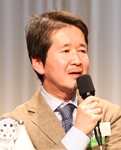Stroll through the Showa-taste Tokyo
January 22, 2014
Mr. Asato Izumi
Columnist
�� I was born in Ochiai located in the northwest part of Shinjuku Ward in Tokyo. My parents�� home was a few blocks away from Ochiai Bunkamura (cultural village), a renowned high-class residential area developed in the early 1920s. Since my childhood, I have enjoyed strolling through the towns and looking at the maps of Tokyo. Tokyo already had an extensive network of bus services in the early 1960s, so my hobby was to take many different routes and mark all the bus stops on the map. This is how I came to memorize the town names in Tokyo that helped my career as a writer when I worked on many essays about the history of buildings in Tokyo.
I was born in Ochiai located in the northwest part of Shinjuku Ward in Tokyo. My parents�� home was a few blocks away from Ochiai Bunkamura (cultural village), a renowned high-class residential area developed in the early 1920s. Since my childhood, I have enjoyed strolling through the towns and looking at the maps of Tokyo. Tokyo already had an extensive network of bus services in the early 1960s, so my hobby was to take many different routes and mark all the bus stops on the map. This is how I came to memorize the town names in Tokyo that helped my career as a writer when I worked on many essays about the history of buildings in Tokyo.
��I took the Tokyo Metro Marunouchi Line to come here today. I got off at Kasumigaseki, one station before, and walked through Hibiya Park where I found members of the Tokyo Senior Nature College taking pictures of gray herons around the Shinji Ike (pond) that dates back to the time when the Park opened in the Meiji era. The Park also gives us a good view of concrete buildings constructed in the 1930s that brings a classic atmosphere to Hibiya area.
��I enjoy finding picturesque buildings in Tokyo. I walked through all the 23 wards in Tokyo over 4 years to collect information to write my articles entitled ��Grand Stroll through the 23 Wards in Tokyo.�� My pedometer counted about 25,000 steps a day, so this duty helped to keep myself fit too. I would like to share with you today some pictures I had taken back then.
��The first picture was taken at an eating place called Sakae-ya in Kanda. The short curtain hanging outside reads ��milk hall�� and gives us a nostalgic Showa-taste as such halls were popular in the early 1920s when milk was still a delicacy for many Japanese. Sakae-ya is still in business today. This wooden restaurant uses copperplate for its facade to give a Western-style fancy touch to its exterior. Such style is called kanban (sign board) architecture and was popular among mercantile stores in the early Showa era. You can find these stores as you stroll through the backstreets around Kanda, Ueno and Tsukiji. The copperplates were bronze-colored when the stores were first built, but over many years, they now have a tasteful patina green tone. When you look at other kanban architecture stores, they seem to be like concrete buildings but when you go behind the stores, you will find that they are wooden buildings.
��The next picture shows the Otama Inari shrine in Iwamoto-cho, Chiyoda Ward. Its name was taken from a beautiful girl Otama who had worked at a teahouse by a now lost famous pond where she drowned herself.
��I took pictures of the latest fashionable buildings at Akihabara. This area was called the ��electric town�� back in Showa for being a major shopping center for home electric appliances and the post-war black market selling electric cooking stoves and radio parts. Today, the town has become a shopping district for IT gadgets and anime DVDs that attracts many young people.
��Jisshi Elementary School in Chuo Ward was constructed after the Great Kanto Earthquake in the late 1920s. The building is used today as a hall by ward residents, after the school was closed due to a decline in student numbers. The picture shows the elaborate art deco design.
��This picture shows the tower of the Mitsukoshi Main Store at Nihon-bashi. Unfortunately the belvedere has been closed so I have to go up to the rooftop terrace to take pictures of this classic architecture dating back to the early Showa days.
��Ginza Cinepatos is an underground movie theater located at the backstreet of Ginza. Around this traditional theater were many buildings with a distinctive Showa flavor, including the famous Tokyo Onsen (hot spring) that was the first sauna facility in Japan. Ohno-ya is a traditional tabi (Japanese socks) store at the backstreet of Ginza that dates back to the Taisho era. This isolated house is still in business today and its quaint appearance has traces of the time when geisha girls made frequent visits.
��My essay ��Grand Stroll through the 23 Wards in Tokyo�� will be published next month, which compiles my articles that have appeared in an information magazine ��Otona-no-shumatsu (Weekends for Grown-ups)�� over four years. Many buildings are rebuilt in a short cycle in Tokyo, so I had to re-write and revise the content many times. I realized to write a book on the towns in Tokyo was a challenging task.
��As I close my speech, let me encourage you to stroll through many towns when you have time, which is a healthy activity that is free of charge.